by Winding Pathways | Oct 15, 2020 | Nature, Trees
Winding Pathways is partnering with Cornell College, Indian Creek Nature Center, Peoples Church, Prairiewoods, and Trees Forever to present Treasuring our Trees.
Join us via ZOOM to honor and remember the fallen trees in the Cedar Rapids and surrounding areas following the Derecho of August 10, 2020. Sunday, October 25, 12:00 noon to 1:00 p.m. Learn more at www.prairiewoods.org.
Join using Zoom meeting ID 829 4883 0080 & password 056503.
-
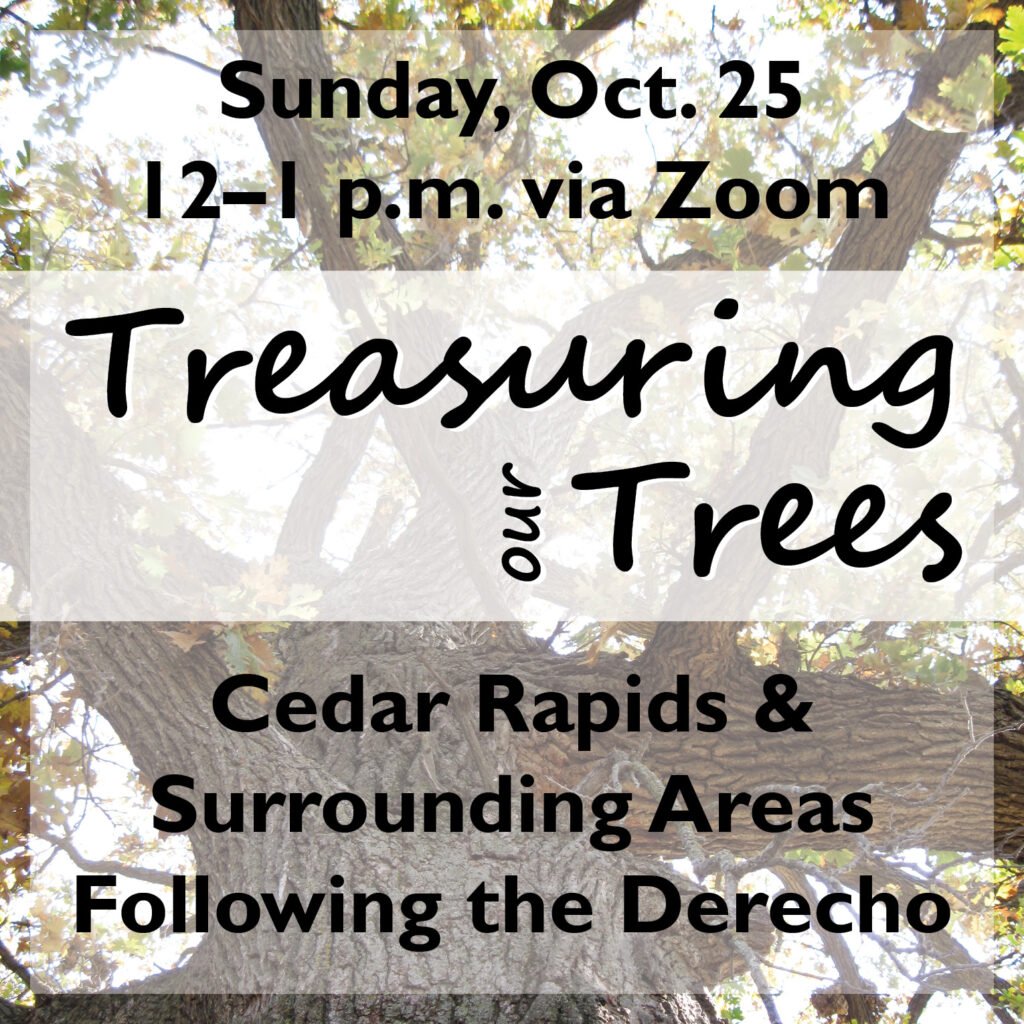
-
ZOOM invitation to honor our trees.
by Winding Pathways | Jan 14, 2020 | Labyrinths, Nature, Trees
2020 The Great Pause
Unlike other years when we have traveled and walked labyrinths along the way, in 2020 we have pretty much stayed at home. Like the rest of the world. That’s OK. We found calm, solace, and yes, even joy.
Remembering day-to-day, when so much seems the same is a challenge, and I can only remember walking a few labyrinths this year. A friend recently termed it “Blursday.”
Except for the Phoenix Harmony Labyrinth in our front yard. That, I have continued to walk every day. And, I am ending my third or fourth year doing so. Indeed a “Blursday” thing. How long HAVE I done this? More on the daily walking later. First, some labyrinths I have been involved with.
Great Plans Gone Astray
It seems that photos mysteriously disappear when I think I have placed them carefully on the computer. Ha! So, the photos of the walks at Westminster Presbyterian in Waterloo, Iowa, that I took in preparation for a March dedication are, like so many other things in 2020 – gone! Poof! The memory is sweet. I’d worked with a team there and colleagues and friends here to create a lovely workshop. We planned to acquaint the larger congregation with labyrinths through music, movement, spiritual readings, and art. By weaving in multiple modalities, we believed people would more readily use the labyrinth on their own and in groups from children to adults in religious education, special interests, and incorporate in formal church services.
The pandemic changed everything. I hope the ceremony happened at some time during the year. There’s been no communication from the church since the program was canceled in early March. May they all be well.
Reconnecting

St. Paul’s in Cedar Rapids is home to a lovely indoor labyrinth. (Photo courtesy Mary H.)
Years ago, Mary H. and I worked together in Lamaze Classes. And, even though our paths diverged, we stayed loosely connected over the years. One day Mary and I visited by distance and she shared about a labyrinth at St. Paul’s Methodist Church on Third Ave SE. What a find! It is beautiful! And, what a treat it will be to walk when the pandemic ends.
From Destruction, A Creation of Healing
After the derecho that struck Iowa on August 10, 2020, a colleague, Edith Starr Chase, pursued creatively repurposing the downed trees and stumps to a labyrinth of natural materials. She found the right place at Wickiup Hill Learning Center. In September, three of us, wearing masks and keeping a distance, blessed the well-chosen site. Flat, surrounded by prairie and a lively marsh. Close to trails. Accessible. Near a parking lot yet, set aside for privacy. The county mowed the area and laid down woodchips. In October Edith and friends began measuring and placing stumps for a truly sublime labyrinth. At the entry stands a young guardian oak. A wide path opens to the tree-stump labyrinth. Walking it, pilgrims feel themselves releasing the trauma of the event, settling into the ground, resting and laying hands on stumps, recalling, restoring. Edith and her friends created a wonderful healing memorial. For the winter solstice, she planned a walk – one of many to come.
-
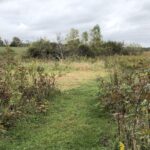
-
A wide path leads to the entry.
-
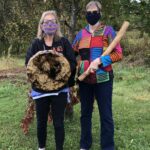
-
The guardian oak awaits the blessing of the labyirnth.
-
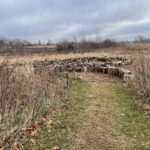
-
The stump labyirnth invites walkers.
-
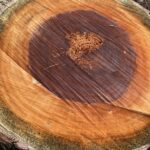
-
Each wood stump has a distinctive color and shape.
-
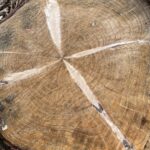
-
Various patterns on the rounds make an interesting walk.
-
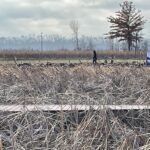
-
Creating beauty from destruction.
The Phoenix Harmony Labyrinth
We started the year with a mild winter’s day New Year’s Day Labyrinth Walk. Teri P. joined others walking for peace, tranquility, hope, and courage. Cold and snow hit later that week and the weather remained cold and snowy for several weeks. Each day, I strapped on snowshoes and crunched along the five-circuit dual entry labyrinth.
Practicing the Shamanic tradition, I often pause at each turn toward the Cardinal Points – East, South, West, North – Below to Mother Earth, Above to Father Sky, and Center – the emerging Bur Oak we planted a few years ago.
-
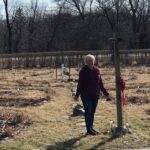
-
Some of us began the year with a New Years Walk.
-
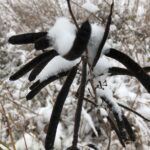
-
Snow captured on seedheads.
-

-
Any weather
Mostly I walk with Gratitude. For all – those I care about, those I don’t know, those I disagree with, and those I do not like. Asking for kindness in my heart and blessings to all. It’s hard sometimes. Insights are important, too. So, it’s OK to let my mind wander a bit and wonder. Nature. Seasons. Love. Hate. What drives people. Thankfulness for our families and this home and property.
-
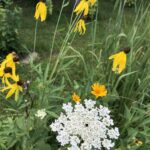
-
Summer denizens.
-

-
Each summer this gnome finds a new home.
-
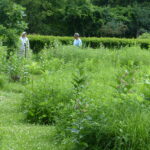
-
More species visit the labyrinth because of the diversity of plants.
-
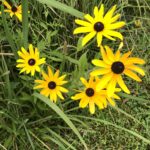
-
Summer riot of color attracts pollinators
-
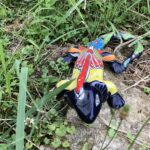
-
Up from Texas!
-
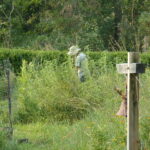
-
After the Derecho friends helped clean up the labyrinth.
Each day is different. The angle of the sun, sprinklings of rain, fog, presence of insects and birds. Tracks and poop in the snow are telltale signs of night visitors. Sometimes I walk before dawn even in winter, looking back at the house’s gentle glow from windows and smoke wafting from the chimney. Other times about 6:40 a.m. a neighbor’s truck lumbers up the road. We exchange a friendly wave. Occasionally, on early winter and summer nights I walk. The solar lights guide my way in winter. By summer the glow of twilight keeps me on the path. A bat swoops. A coyote yips. Crickets sing. Trees creak stiffly. Stars and planets glow.
-
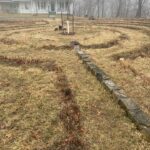
-
One family regularly walks and runs the labyrinth on the astronomical and cross-quarter dates.
-
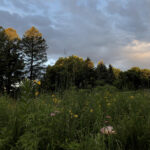
-
Summer delight was watching the sun kiss the sentinel fir trees.
-
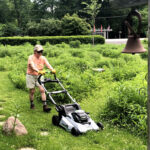
-
Maintaining the labyrinth is work. And a way to connect.
-

-
Remnants of the Derecho blown into the labyrinth.
-
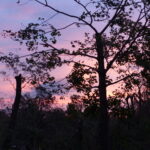
-
Sunrise after the derecho.
-
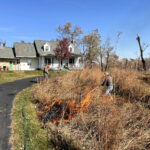
-
The most thrilling activity each fall is burning the Phoenix Harmony Labyrinth.
-
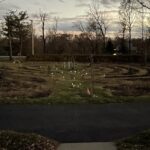
-
Evening walk by solar lights.
-
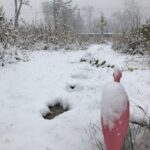
-
Surpise!
-
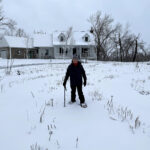
-
On our first lasting snow, I strapped on the snowshoes to walk the labyrinth.
It’s all good. A discipline and a joy.
by Winding Pathways | Nov 21, 2019 | (Sub)Urban Homesteading, Birds, Foraging, Garden/Yard, Nature, Trees
A New World Thanksgiving
Almost every meal Americans enjoy comes from animals and plants that trace their origin to many continents.
Cattle, sheep, chickens, and pigs, for example, are all natives of the Old World brought to America soon after it was settled by Europeans. Wheat, rice, and many other plant foods are also newcomers that were unknown to Native Americans.
One annual feast mostly made from original American foods is Thanksgiving. This year why not create this traditional feast from entirely plants and animals that were found here before Columbus?
Turkeys
Turkey highlights the Thanksgiving dinner. See our previous blog on this amazing and tasty bird. Here are plants native to North and South America to complement roast turkey:
Fruits and Vegetables
Corn: Corn has been grown in Central America for thousands of years. It’s cultivation gradually spread north and east and became a staple food for Native Americans. When hungry Pilgrims landed in what became Massachusetts they found and stole caches of corn stored by local tribes, no doubt causing bad feelings.
Cranberries: Most commonly eaten fruits originated in Europe or Asia, but the cranberry is an American native.
Squash and Pumpkins: Dozens of varieties of winter squash come in many shapes, colors and sizes, and the pumpkin is actually a squash. Butternut, Hubbard, acorn, or any other squash is delicious on the Thanksgiving dinner table, and dessert of pumpkin pie rounds out a tasty meal.
Potatoes: Common potatoes also originated in South or Central America and have been an important food for thousands of years. Mashed or baked, they go well with turkey, squash, and cranberries.
Sweet Potatoes: Originally from South America, these are among the most nutritious of foods. Similar yams have an African origin, so for a local dinner stick with sweet potatoes.
The sweetness from the Maples
Maple Syrup: While honey is made by bees that came from the Old World, maple syrup is America’s sweetener. It’s delicious on squash or sweet potatoes.
Beans: Native American gardens usually featured three plants: beans, squash, and corn. Commonly called The Three Sisters combined they create a balanced diet.
A diet of many foods that originally came from the Americas makes a delicious an interesting Holiday meal. We tend to thank modern geneticists for creating abundant food, but beans, corn, squash, sweet potatoes, maple syrup, cranberries, and turkey were all domesticated and enjoyed by Native Americans long before Columbus set sail.
-

-
Cranberry Pie brightens any Thanksgiving table.
-
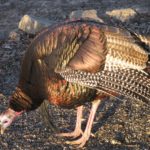
-
Cook Wild turkey differently than domesticated ones.
-
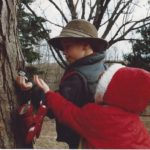
-
Maple syrup can sweeten many Thanksgiving meals.
by Winding Pathways | Nov 7, 2019 | Nature, Travel/Columns, Trees

Enjoying Iowa’s forests.
Iowa is one of the states with the fewest trees, yet in the late 1800s we were the Lumber Kings of the World! And,

Notice the tree rings on this wide board from New Hampshire
Clinton, Iowa’s minor league baseball team proudly retains that name – Lumber Kings! Why? Read The Green Gazette (9-29-2019, Living L-09 and 10) to learn about Iowa’s forest industry, where you can camp today in quiet forests and how lumbering put Clinton, Iowa, on the map.
by Winding Pathways | Sep 19, 2019 | (Sub)Urban Homesteading, Foraging, Nature, Trees
Delicious, Erratic Acorns
Our back deck at Winding Pathways is an outstanding vantage point for watching butterflies, birds, and even our evening aerialist bats. The deck is perched over a deep, cool ravine with a stately black oak hovering above. That can be a problem.
In most autumns our black oak cascades acorns down to the ground and our deck. Removing them takes aggressive sweeping. Despite the hassle we love acorns.
Acorns are, of course, the seeds of oak trees. Hundreds of oak species live across much of the northern hemisphere. They can be a little tricky to identify since oaks sometimes hybridize and look like a blend of two or more species. Many people use leaf shape to identify trees, but oaks may throw a curve. Often leaves, called sun leaves, up on the top of an individual tree are smaller and may have a somewhat different shape than those down lower on the same tree. It can be confusing.
There are two general oak types, the white and red oak groups. White oak type trees include species commonly called white, swamp white bur (sometimes spelled burr), chinkapin also spelled chinquapin, and chestnut oaks. Their leaves have rounded lobes and they produce large acorns with low acid content. Red oak type trees include species commonly called red, black, and pin oaks. Their leaves have pointed lobes and their acorns are usually small and laden with bitter acid.
-
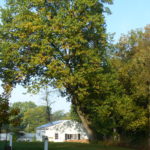
-
Acorns from the black Oak are small and bitter.
-
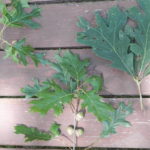
-
Oaks have different shaped leaves
-
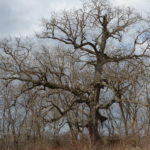
-
Century Oak Tree
-
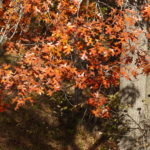
-
Oak leaves turn russet in autumn.
Acorns
Acorns are nature’s gift to many wildlife species and people. Few seeds are as abundant, large, and nutritious as acorns. Squirrels, chipmunks, muskrats, woodchucks, deer, bears, blue jays, wild turkeys, and a host of other animals gorge on them. The calorie-rich nuts help wildlife put on fat that helps them survive the coming winter.
But, there’s a problem. Oaks are erratic acorn producers. As a general rule, the white oak types only create a heavy crop every few years. Red oak type trees are more reliable but still sometimes skip a year of seed production. Sometimes few oaks in a vast area will produce acorns while an individual tree here and there will be loaded. Find a heavy acorn bearer in a scare year and you’ll have the company of many animals feeding on the nutritious nuts. Part of the reason for erratic crops stems from pollination. Oaks are wind-pollinated and a long spell of rain when they bloom in the spring can dampen pollination and eliminate a crop that autumn.
-
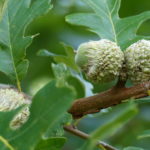
-
Acorns set up in the spring
-
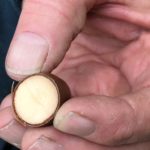
-
The white meat of an acorn.
-
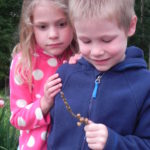
-
Two kids check out the acorns on a branch
-
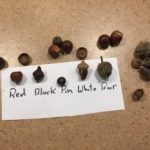
-
Iowa has many types of oaks
Acorns are a delicious human food that was relished by native people across the globe. To learn more about acorns and how to process them into food check out the Winding Pathways blog of August 2014 called Delicious Acorns.
by Winding Pathways | Jul 11, 2019 | (Sub)Urban Homesteading, Garden/Yard, Trees
Early one May afternoon we arrived home, glanced into the woods past our property, and were astonished to see an enormous red oak on the ground. The tree looked healthy, solid, and unlikely to topple, but it fell on a clear calm day. On its way down the old veteran broke two younger trees growing nearby.
A week or so later we woke to an enormous crash. It was pitch dark so we were only able to search around with a flashlight to learn that nothing had hit our house. The next morning, we discovered a giant elm prostate on the ground about 150 feet from our bedroom on a neighbor’s property. Like the oak, it fell when it was calm. Unlike the oak, the elm had been dead for years and many mushrooms were growing from its trunk.
We enjoy a huge diversity of birds and other wildlife in our yard, in part because we adjoin Faulkes Heritage Woods, a 110 wild forest protected by a conservation easement. The Woods have not been logged for over a century, so many enormous oaks, hickories, and maples live there. Many are dead or in decline, but that’s great for wildlife.
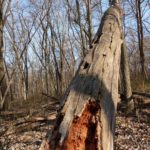
Dead trees provide food and nesting sites
Of all landscape features few are as valuable to as many wildlife species as an old dead tree. Nearly as soon as a tree dies insects, bacteria, and fungus begin the long process of recycling wood and bark back into humus. Woodpeckers drill into dead trees to extract tasty insects and carve out nesting cavities. Often their old cavities are used by chickadees, wrens, and many other cavity nesters. Dead trees are favored perching sites for raptors, perhaps because they are leafless, so the sharp-eyed birds can spot prey on the ground.
We let dead trees stand on our property, as long as they are far enough away from the house so they can’t cause damage or injure someone when they crash down.
Are Dead Trees Dangerous
We’ve been in the right place at just the right time to see big trees fall. Usually, there’s a crack or two before a giant tree crashes down with lightning speed. If someone were underneath it then it would be hard to run fast enough to escape injury.
The odds of a person being hit by a falling tree while walking along a trail are infinitesimally small. It almost never happens. Most injuries and fatalities occur when people camp, picnic, or sit under a tree. The risk comes because they are under the tree for hours while sleeping or in a position where they can’t run and escape quickly.

Look up when placing your tent near trees.
Before setting up a tent always look up and never pitch it under a weak or dead tree that could fall in the night.
How to Tell If A Tree Is Likely to Fall
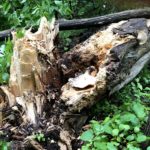
It’s a wonder this tree stood as long as it did.
Determining if a tree is likely to fall isn’t always easy. Sometimes seemingly healthy strong trees fall over, but often one gives notice that it is in decline and weakening. Here are visible signs that a tree is vulnerable to falling:
- It’s dead. No leaves. Branches occasionally dropping off. Bark sheathing off.
- It’s alive but increasingly branches are dying and are bare of leaves.
- Mushrooms are growing from the wood.
- Little piles of sawdust at the base show that insects or woodpeckers have been at work.
- It’s old. As trees age, they stiffen and eventually, their wood weakens. Young healthy smaller trees are more flexible and bend back and forth in heavy wind without damage. Wind can crack the wood of old stiff trees.
- All trees eventually fall down but some have notoriously weak wood that breaks easily. Silver maples, black locust, and Siberian Elms often shed big limbs or break during storms.
Should I Have A Tree Taken Down?
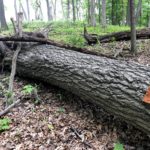
Log ready to be bucked up to firewood.
Losing a beautiful old tree is painful, but there is a time when the tree should be removed to prevent an injury, death, or damage. At Winding Pathways, we let even old weak trees stand as long as they are well away from the house or places where sit. But if the tree could fall and hit a parked car, house or barn we call a tree service and have it repurposed into firewood.
This Youtube video provides an excellent overview of live and dead trees, saving or cutting the appropriate trees. My Woodlot.










































